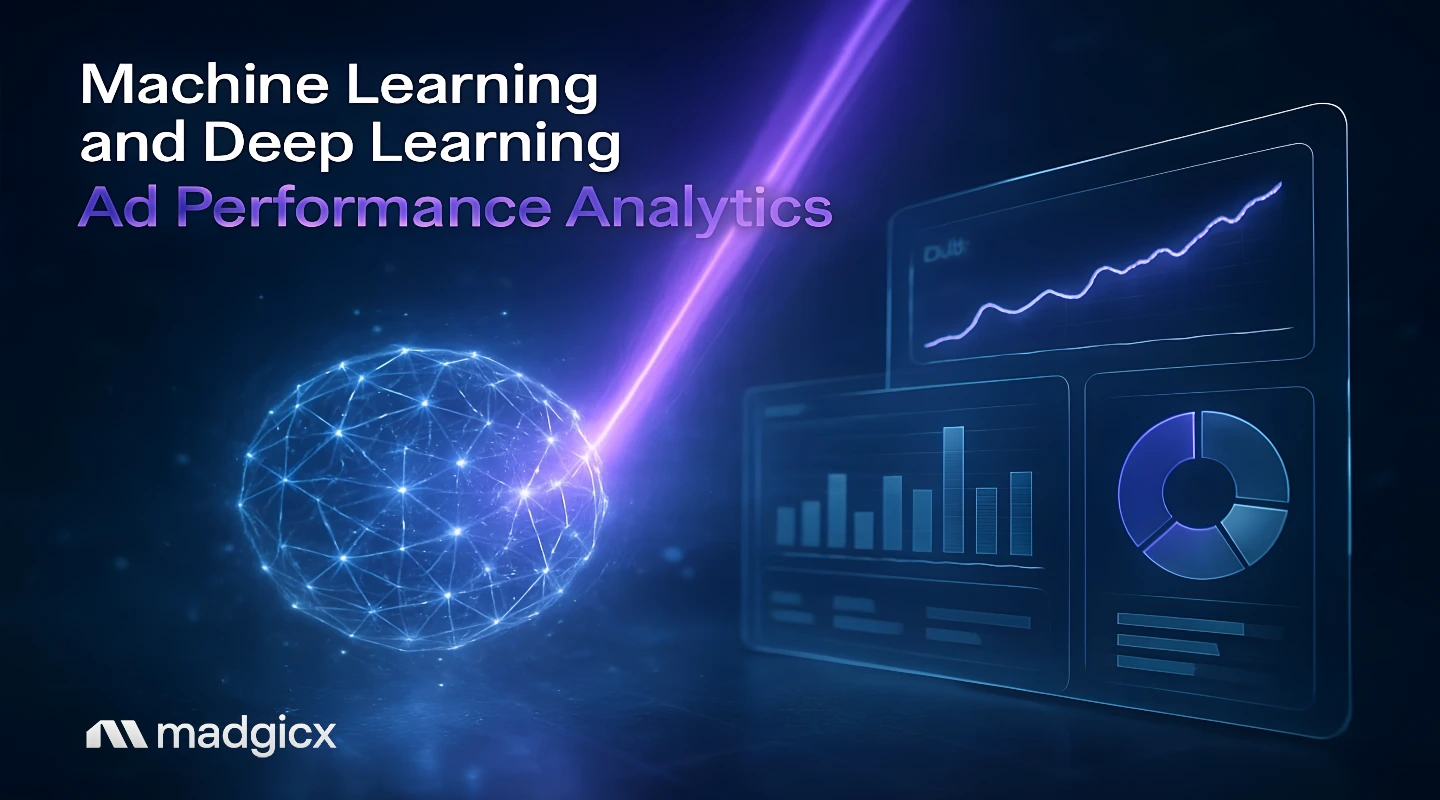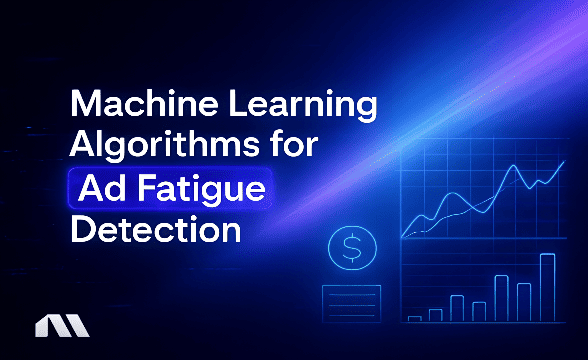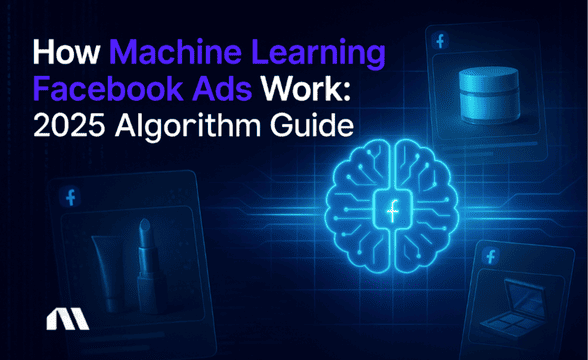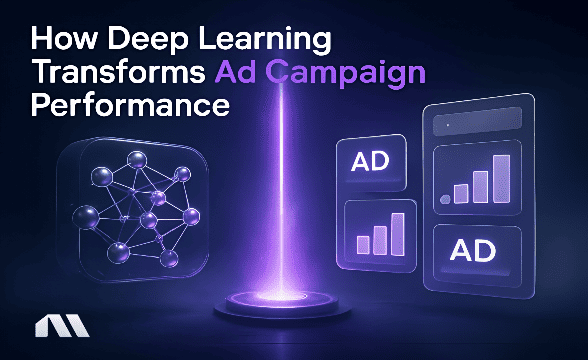Master machine learning and deep learning ad performance analytics with our implementation guide. Increase CTR and improve ROAS with AI strategies.
Ever feel like you're fighting an uphill battle with your ad campaigns? You're not alone.
While AI-optimized advertising campaigns are delivering 2x higher click-through rates and up to 50% ROAS increases, and 88% of marketers now use AI daily, most advertisers are still struggling with implementation. The big question isn't whether AI works—it's figuring out whether to start with basic machine learning or jump straight into advanced deep learning approaches.
Here's the thing: traditional advertising methods are hitting a wall in our data-driven era. Manual optimization can only take you so far when you're competing against algorithms that process millions of data points per second.
But here's the good news—machine learning and deep learning ad performance analytics use algorithms to help optimize advertising campaigns by analyzing vast datasets to predict user behavior, personalize creative, and adjust bidding in real-time. ML handles structured data and specific tasks, while deep learning processes complex, unstructured data through multi-layered neural networks, designed to deliver 14-52% performance improvements across key metrics.
Ready to evolve your campaigns from manual optimization to data-driven performance? Let's dive into the complete roadmap.
What You'll Learn
By the end of this guide, you'll have a complete understanding of how machine learning and deep learning differ in advertising applications and when to use each approach. We'll walk through 5 core ML/DL applications designed to deliver measurable performance improvements across targeting, bidding, creative optimization, attribution, and forecasting.
You'll get a step-by-step 12-week implementation timeline with weekly milestones and troubleshooting checkpoints, plus a performance benchmark framework to evaluate success across CTR, conversion rates, ROAS, and CAC metrics.
As a bonus, we're including a platform selection decision tree and ROI calculation methodology to help you make smart investment decisions.
Understanding Machine Learning vs Deep Learning in Advertising
Think of machine learning as your highly skilled digital assistant who learns from every campaign you run. Deep learning? That's like having an entire team of specialists, each focusing on different aspects simultaneously.
Machine learning in advertising refers to algorithms that learn from data to make ad performance predictions, helping optimize specific tasks like audience targeting and bid management using structured data. It's perfect for tasks where you have clean, organized information—like conversion rates, click-through rates, and demographic data.
Deep learning is a subset that uses multi-layered neural networks to process complex data patterns, enabling advanced features like creative optimization and real-time personalization with unstructured inputs. Think images, natural language, and complex behavioral patterns that traditional algorithms struggle to interpret.
The Key Distinction
ML requires clean, structured data to function effectively. Deep learning can work with messy, unstructured inputs like images and natural language, making it incredibly powerful for creative optimization and sophisticated personalization.
When should you use which approach? Start with ML for basic optimization tasks—it's more accessible and delivers quick wins. Move to deep learning for advanced personalization and creative optimization once you've mastered the fundamentals and have sufficient data volume.
For performance marketers, this distinction matters because it determines your implementation strategy. If you're managing campaigns with solid conversion tracking and clean data, ML can deliver immediate improvements. If you're looking to scale creative testing or implement advanced personalization, deep learning becomes essential.
Pro Tip: Most successful implementations start with platform-native ML features (like Smart Bidding) before advancing to custom deep learning solutions. This approach builds foundational knowledge while delivering immediate results.
5 Core Applications Transforming Ad Performance
Here's where the magic happens. These five applications are where ML and DL stop being buzzwords and start delivering real results that show up in your monthly reports.
Predictive Audience Targeting
How it works: Algorithms analyze user behavior patterns to help identify high-value prospects before they convert. Instead of waiting for users to show purchase intent, ML models predict who's most likely to convert based on subtle behavioral signals.
Performance impact: 32% boost in conversion rates through ML-based segmentation compared to traditional demographic targeting. The algorithms identify patterns humans miss—like the correlation between specific browsing sequences and purchase probability.
Madgicx example: Our AI-powered lookalike Meta ad audience creation uses deep learning models trained on millions of successful conversions. Instead of basic demographic matching, it identifies behavioral and interest patterns that predict conversion likelihood, often discovering unexpected audience segments that outperform traditional targeting.
You can try it for free for a week.
Dynamic Creative Optimization
How it works: Real-time personalization of ad content based on user context and behavior. The system automatically adjusts headlines, images, calls-to-action, and even color schemes based on what's most likely to resonate with each individual user.
Performance impact: 2x higher CTRs with AI-optimized creatives versus manual designs. The system tests thousands of combinations simultaneously, learning which elements work best for different audience segments.
Madgicx example: Our AI Ad Generator is trained on high-converting Meta ad patterns from millions of successful campaigns. It doesn't just create random variations—it understands what visual elements, copy structures, and design principles help drive conversions in your specific industry.
Automated Bidding & Budget Optimization
How it works: Millisecond-by-millisecond bid adjustments based on conversion probability. The system analyzes hundreds of signals—time of day, device type, user behavior, competitive landscape—to determine the optimal bid for each auction.
Performance impact: 35% ROAS increase through deep learning predictive bidding compared to manual bid management. The algorithms react to market changes faster than any human could.
Madgicx example: AI Marketer's 24/7 budget optimization continuously monitors your campaigns and adjusts spending based on real-time performance. It can shift budget from underperforming ad sets to winners within minutes, not hours or days.
Attribution & Performance Tracking
How it works: ML models connect customer touchpoints across fragmented data sources, helping solve the attribution puzzle that's plagued marketers since iOS 14.5. The system builds probabilistic models of customer journeys, filling in the gaps where traditional tracking fails.
Performance impact: Companies using advanced attribution models report reduced invalid traffic to less than 10% of industry average, dramatically improving data quality for optimization decisions.
Madgicx example: Our server-side tracking solution creates a cookieless attribution system for iOS-impacted campaigns, using machine learning to model customer journeys and provide accurate conversion data back to Facebook for optimization.
Performance Forecasting
How it works: Predictive models forecast campaign outcomes before launch, analyzing historical performance, market conditions, and competitive factors to predict success probability. This enables better budget allocation and creative strategy decisions.
Performance impact: 90% accuracy in predicting creative success versus 52% human judgment. The models identify winning creative patterns before they're even launched.
Madgicx example: Our ROI prediction models analyze your Meta account history and market data to forecast campaign performance, helping you allocate budget to the highest-probability opportunities and avoid costly testing mistakes.
Pro Tip: Start with one application at a time. Master predictive targeting before moving to dynamic creative optimization. This sequential approach ensures you build expertise while maintaining campaign stability.
Performance Improvement Benchmarks
Let's talk numbers. Here's what you can realistically expect when you implement these technologies correctly, based on data from thousands of campaigns across multiple industries.
Click-Through Rate Improvements
- Traditional campaigns: Baseline performance
- Basic ML implementation: 15-20% improvement
- Advanced ML: 50-75% improvement
- Deep learning: Up to 100% improvement
Conversion Rate Gains
- Basic ML: 14% average increase
- Advanced ML: 20-25% improvement
- Deep learning: 35-40% improvement
Return on Ad Spend (ROAS)
- Basic ML: 10-15% improvement
- Advanced ML: 25-35% improvement
- Deep learning: 35-50% improvement
Customer Acquisition Cost (CAC)
Progressive reductions from 15% with basic ML to 52% with advanced deep learning implementations.
Time Savings
- Campaign setup time reduced by 50% with basic automation
- Advanced implementations deliver up to 90% time savings on routine optimization tasks
Real-World Case Studies
MediaGo achieved a 170% conversion rate increase and 8.8% ROAS improvement using deep learning models for ad performance prediction.
A Madgicx client saw 83% ROAS improvement in their first week of AI implementation. One global agency reported 111% campaign volume increase while maintaining stable ROAS.
ROI Examples
Marketing automation consistently delivers up to 544% ROI in peak performance studies. Companies with strong AI investments report 10-20% ROI improvements consistently, with revenue growth of 3-15% across industries using AI in advertising.
Pro Tip: These benchmarks assume proper implementation with adequate data volume. If your account has less than 50 conversions per week, focus on traffic generation before implementing advanced AI features.
12-Week Implementation Timeline
Rome wasn't built in a day, and neither is a high-performing AI-optimized ad account. Here's your roadmap to success, broken down into manageable phases with clear checkpoints.
Phase 1: Foundation Setup (Weeks 1-2)
Week 1: Data Audit & Baseline
Your first priority is ensuring you have clean conversion tracking. Audit your current setup and verify you're getting at least 50 conversions per week—this is the minimum data volume needed for basic ML features to function effectively.
Week 2: Platform Selection & Goal Setting
Choose your starting platform based on where you have the most data and highest conversion volume. Set clear, specific KPI goals—not vague "improve performance" but concrete targets like "increase ROAS by 25%" or "reduce CAC by 30%."
What you should see: Clean data flowing into your analytics, baseline performance documented across all key metrics.
Checkpoint: If your conversion volume is below 50 per week, pause AI implementation and focus on traffic generation and conversion rate optimization first. AI needs data to learn from.
Phase 2: Initial ML Implementation (Weeks 3-4)
Week 3: First AI Campaign Launch
Launch your first AI-optimized campaign with 10-20% of your total budget allocation. This conservative approach lets you test effectiveness without risking your entire account performance.
Week 4: Enable Platform ML Features
Turn on Smart Bidding, Advantage+ campaigns, or equivalent platform-native ML features. Here's the crucial part: avoid making manual changes during this period. Let the algorithms learn.
What you should see: "Learning" status indicators across your campaigns, some performance fluctuations as algorithms gather data.
Checkpoint: If performance drops more than 30%, check your tracking setup but resist the urge to pause AI features. Learning phases often include temporary performance dips.
Phase 3: Learning & Optimization (Weeks 5-8)
Weeks 5-6: Pattern Recognition Phase
AI algorithms begin identifying patterns in your data. Performance should start stabilizing as the system learns which audiences, placements, and bidding strategies work best for your specific goals.
Weeks 7-8: Performance Comparison
Compare AI-optimized campaigns against your control groups. Document learnings about which approaches work best for your account and industry.
What you should see: Consistent improvements emerging, cost efficiency gains, reduced need for manual optimization.
Checkpoint: If you're not seeing improvement by Week 8, assess your data volume and setup. You may need more conversion volume or better tracking implementation.
Phase 4: Advanced Features (Weeks 9-12)
Weeks 9-10: Dynamic Creative & Expansion
Add dynamic creative optimization and expand successful AI approaches to additional campaigns. This is where machine learning algorithms really start showing their power.
Weeks 11-12: Predictive Audiences & Scaling
Implement predictive audience features and scale successful approaches across your entire account. Consider advanced attribution and forecasting tools.
What you should see: Sustained performance improvements, significantly reduced management time, consistent scaling without performance degradation.
Checkpoint: You're ready for full-scale deployment and advanced deep learning features if you're seeing consistent improvements and reduced manual work.
Troubleshooting Decision Points
- Performance decline in Weeks 2-4: This is normal during the learning phase—maintain course
- No improvement by Week 6: Review data quality and conversion tracking setup
- Inconsistent results: Check for external factors like seasonality or competitive changes
Pro Tip: Document everything during implementation. The patterns you identify will be invaluable when scaling to additional accounts or campaigns.
Platform & Tool Selection Framework
With dozens of AI advertising tools available, choosing the right starting point can feel overwhelming. Here's how to cut through the noise and make smart decisions based on your specific situation.
Platform-Native ML Features (Start Here)
Google Ads: Smart Bidding, Responsive Search Ads, Performance Max campaigns provide solid ML foundations without additional costs.
Meta Ads: Advantage+ campaigns, automatic placements, and lookalike audiences offer powerful AI optimization built into the platform.
TikTok Ads: Smart Creative, automated bidding, and interest targeting expansion deliver strong results for video-focused campaigns.
Best for: Beginners, limited budgets, testing AI effectiveness before investing in specialized tools.
Comprehensive AI Platforms (Scale Here)
Madgicx: AI-powered Meta ad management with AI Marketer, creative intelligence through our AI Ad Generator, and advanced attribution solutions. Perfect for e-commerce businesses and agencies managing multiple accounts.
Criteo: Cross-channel dynamic creative optimization and predictive bidding, strong for retail and e-commerce.
RTB House: Deep learning retargeting and personalized creative generation, excellent for advanced remarketing strategies.
Best for: Scaling successful AI implementations, multi-platform management, businesses ready for comprehensive automation.
Specialized AI Tools (Advanced Applications)
Creative Optimization: AdCreative.ai for display ads, Persado for copywriting optimization, Pencil for video ad creation.
Analytics: Pathmonk Intelligence for conversion optimization, Koast.ai for attribution, Adverity for data consolidation.
Attribution: Triple Whale, Northbeam, and Hyros for advanced cross-platform tracking.
Best for: Specific use cases, enterprise implementations, businesses with dedicated AI teams.
Selection Decision Tree
Budget under $5,000/month: Start with platform-native tools to test AI effectiveness and build foundational knowledge.
Budget $1,000-$25,000/month: Invest in comprehensive platforms like Madgicx that offer full-service AI optimization with human support.
Budget over $25,000/month: Consider custom solutions combined with specialized tools for maximum optimization potential.
E-commerce focus: Madgicx offers the best Shopify reporting integration and e-commerce-specific optimization features.
Agency operations: Look for multi-client management platforms with white-label capabilities and team collaboration features.
Implementation Best Practices & Common Pitfalls
After analyzing hundreds of AI implementation attempts, these patterns separate the winners from the frustrated. Let's make sure you're in the winner's circle.
Success Factors
Data Quality First: Clean conversion tracking beats sophisticated algorithms every time. Spend time getting your attribution right before implementing advanced AI features.
Patience During Learning: Allow 4-8 weeks for meaningful optimization. Real-time decision-making in advertising requires time to identify patterns and optimize performance.
Gradual Budget Allocation: Start with 10-20% of your budget, scale based on performance. This approach minimizes risk while allowing adequate testing.
Clear Goal Setting: Set specific KPIs, not vague "improve performance" objectives. AI typically performs best when it has clear targets to optimize toward.
Human-AI Balance: AI optimizes tactics, humans own strategy. The most successful implementations combine AI automation with human oversight and creativity.
Common Pitfalls
Making Manual Changes During Learning: This kills AI effectiveness. Resist the urge to "help" the algorithm during its learning phase.
Insufficient Conversion Volume: You need a minimum of 50 conversions per week for basic ML. Advanced features require even more data.
Unrealistic Timeline Expectations: Expecting results in days, not weeks, leads to premature optimization and poor decisions.
Over-Optimization: Changing too many variables simultaneously makes it impossible to identify what's actually working.
Ignoring External Factors: Seasonality, competitive changes, and market conditions affect AI performance just like manual campaigns.
Pro Tips for Success
Use broad match keywords with Smart Bidding for maximum AI learning potential. Test AI on campaigns with clean measurement first—this gives you the clearest view of AI impact.
Maintain control groups to measure AI impact accurately, and document learnings for scaling to additional campaigns.
Consider implementing machine learning models using creative performance metrics to optimize your creative strategy alongside your targeting and bidding optimization.
Pro Tip: The biggest mistake is trying to implement everything at once. Pick one AI feature, master it completely, then expand. This approach builds expertise while maintaining campaign stability.
Frequently Asked Questions
How much data do I need to start using machine learning for ads?
Minimum 50 conversions per week for basic ML features like Smart Bidding. For advanced deep learning applications, aim for 200+ conversions weekly. If you're below these thresholds, focus on traffic generation and conversion rate optimization first. The algorithms need sufficient data to identify patterns and make accurate predictions.
What's the difference between machine learning and deep learning for advertising?
Machine learning handles structured data and specific optimization tasks like bid management and audience targeting. Deep learning uses multi-layered neural networks to process complex, unstructured data for advanced applications like creative optimization and real-time personalization. Start with ML for immediate wins, advance to DL as you scale and need more sophisticated optimization.
How long before I see results from AI-optimized campaigns?
Initial signals appear in 7-14 days, meaningful optimization develops over 4-6 weeks, and full performance potential typically emerges in 8-12 weeks. The learning phase requires patience but is designed to deliver sustained improvements. Don't expect overnight transformations—AI optimization is a marathon, not a sprint.
Can AI completely replace human campaign management?
No, and that's actually a good thing. AI excels at tactical optimization—bidding, placement, timing—but humans remain essential for strategy, messaging, creative direction, and goal setting. The most successful implementations combine AI automation with human oversight and creativity. Think of AI as your incredibly capable assistant, not your replacement.
What if AI underperforms compared to manual management?
Common causes include insufficient data volume, poor tracking setup, unrealistic expectations, or making manual changes during the learning phase. Review data quality, ensure proper attribution, and allow adequate learning time before making adjustments. Remember, even the best AI needs good data and clear objectives to succeed.
How do I know if my AI implementation is working?
Look for consistent improvements in your key metrics over 4-8 weeks, reduced time spent on manual optimizations, and stable or improving performance as you scale. Machine learning models in marketing analytics should show clear patterns of improvement once properly implemented.
Start Your AI Transformation Today
We've covered a lot of ground here, but the key takeaways are clear: machine learning and deep learning ad performance analytics are designed to deliver measurable improvements with 2x CTR increases, 50% ROAS improvements, and 52% CAC reductions when implemented correctly. Success requires proper foundation work—clean data, adequate conversion volume, and realistic timelines.
The implementation path follows proven phases: foundation setup, careful testing, systematic optimization, and strategic scaling. Your platform selection should align with your budget, goals, and technical requirements, starting with native tools and advancing to comprehensive solutions as you scale.
Here's the reality check: AI implementation isn't instant magic. It requires patience, proper setup, and strategic thinking. But for performance marketers willing to invest the time and effort, the results speak for themselves. Companies implementing AI advertising strategies consistently outperform those relying on manual optimization alone.
Your next action depends on where you are today. If you're just starting with AI, begin with platform-native ML features on your best-performing campaigns. If you're ready for comprehensive automation and have the budget to support it, explore solutions like Madgicx that offer AI-powered optimization across your entire Meta advertising operation.
The AI advertising revolution is happening now. The question isn't whether you should adopt these technologies—it's how quickly you can implement them effectively. Start with the foundation, be patient during the learning phase, and prepare to scale when the results prove themselves.
Your competitors are already using AI to optimize their campaigns. The longer you wait, the bigger their advantage becomes. But with the roadmap we've outlined here, you have everything you need to not just catch up, but potentially leapfrog the competition entirely.
Reduce time spent on manual campaign management. Madgicx's AI Marketer uses advanced deep learning models to help optimize your Meta ads 24/7, designed to deliver up to 83% ROAS improvements while you focus on strategy.
Digital copywriter with a passion for sculpting words that resonate in a digital age.







.avif)







